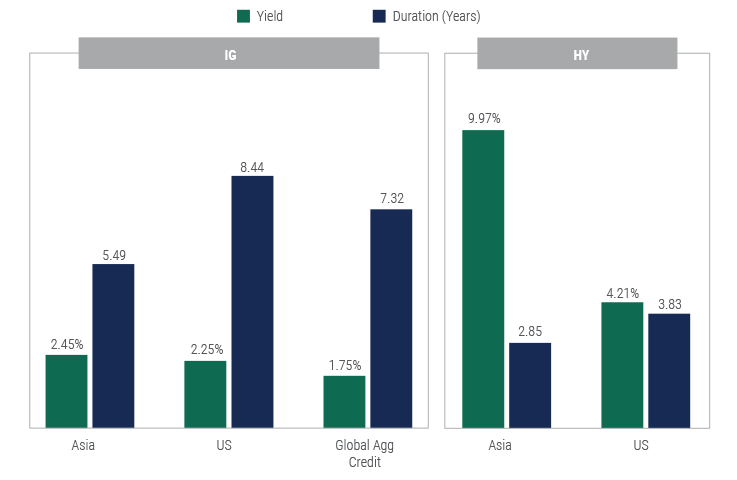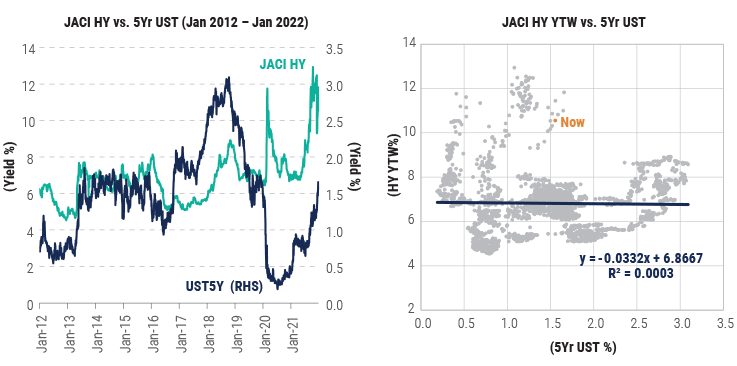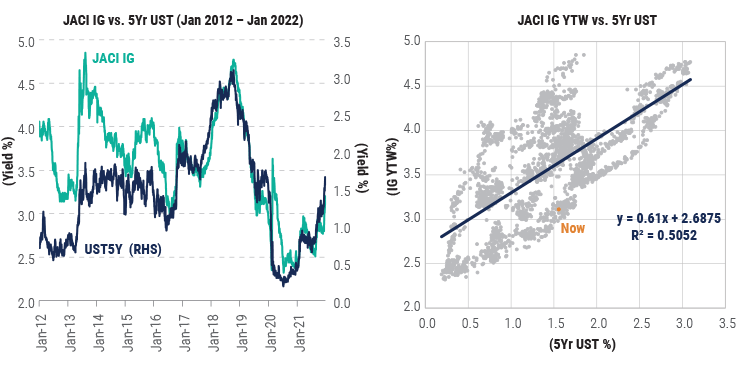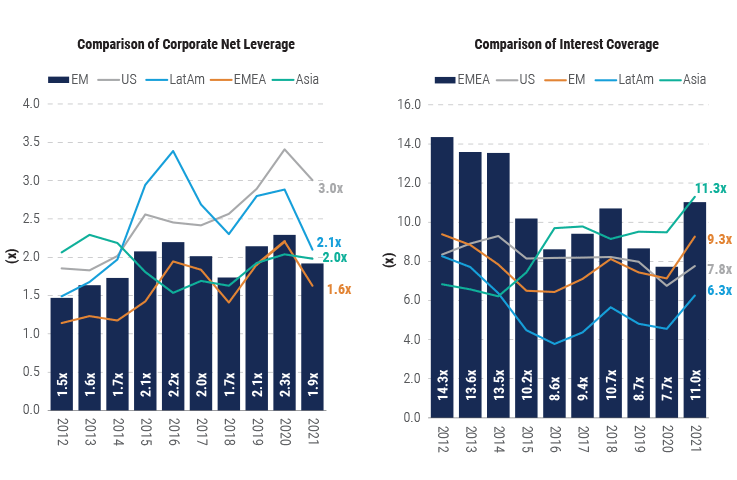Building a Moat Against Rising Rates With Asia Bonds

Emily Lam
Client Portfolio Manager, Fixed Income

As the US Federal Reserve raises interest rates to curb inflation, the challenge for investors remains: how to position for this policy pivot?
Rising rates call for robust risk management, as bond values typically fall. For investors with greater flexibility to navigate the global fixed income markets, Asia bonds offer a differentiated risk profile that, we believe, would make them valuable and timely holdings to insulate global portfolios from rate risks as well as emerging geopolitical risks.
Duration management
Overweighting short duration is one of the primary strategies to mitigate interest rate change risk. The longer the bond’s duration, the more its value is likely to fall as interest rates rise. Therefore, holding shorter-duration bonds helps lower the volatility of bond prices in a portfolio.
Asia bonds offer the advantage of shorter duration than US and Global Aggregate peers, both in the investment grade (IG) and high yield (HY) segments. For example, Asia IG has approximately three years shorter duration than US IG, but offers incremental yield. Similarly, a comparison of US HY and Asia HY highlights the latter’s shorter duration, but with nearly double the yield.
This higher yield/shorter duration profile potentially offers wider room for spreads to tighten and help absorb rate changes. Active duration management at the portfolio and security level, adjusted according to the direction of interest rates, should minimize the risk of erosion in bond values and potentially enhance returns.
Asia Duration Is Shorter Than Peers’ With Better Yield

Source: Bloomberg, PineBridge Investments as of 15 February 2022. For illustrative purposes only. We are not soliciting or recommending any action based on this material. Duration is a measure of the bond’s sensitivity to changes in interest rates. Yield refers to the rate of return if bonds are held to maturity. The rate of return includes the coupon payments received during the term of a bond and its principal repayment upon maturity.
Low correlation to US Treasuries
Over the medium to long term, we believe the rising rate cycle will have a moderate impact on Asia credit. Over the past 10 years, the sensitivity of Asia investment grade bonds to interest rates measures at 0.5 R-squared, which indicates it is moderately correlated.1 Within Asia high yield segment, the sensitivity is negligible at 0.0003. This suggests that holding Asia bonds should be more favorable than US bonds, particularly at the beginning a rate hike cycle.
Historical Correlations Between Asia Bonds and US Treasuries
Asia HY vs. 5 Yr UST - negligible correlation

Asia IG vs % 5 Yr UST - moderate correlation

Source: Bloomberg, PineBridge as of 31 January 2022. JACI refers to the J.P. Morgan Asia Credit Index. YTW refers to yield to worst, which refers to the lowest possible yield you may receive on a bond assuming the issuer does not default. For illustrative purposes only. We are not soliciting or recommending any action based on this material.
Credit spreads for the high yield sector continue to trade at historically wide levels due to ongoing concerns within the China property space. But with ultra-low correlation to US Treasuries, the wider credit spreads within the segment should provide a buffer to offset the rise in interest rates.
Stable credit fundamentals
The advantages of duration management and low correlation could be amplified by credit quality selection. Credit metrics are steady for Asia corporates -- leverage has shown a stable trend over the past five years, and issuers’ liquidity is improving overall. Fundamentals for corporates in Asia are expected to remain strong on the back of an anticipated broader macro recovery in the region. We believe this environment will support a spread tightening bias against US bonds.
Asia Credit Metrics Remain Steady

Source: BAML, PineBridge Investments as of 30 June 2021. For illustrative purposes only. We are not soliciting or recommending any action based on this material.
The US dollar Asia IG market, for instance, has grown to nearly US$1 trillion2 and offers a diversity of high-quality issuers (with an A- average credit rating) beyond China, including emerging markets such as Indonesia and the Philippines, as well as developed economies like Singapore, Hong Kong, and South Korea. The significant presence of quasi-sovereigns is a key characteristic of the market unlike its peers. Asia IG fallen angel risk remains low compared to peers and potential credit events are isolated to certain sovereigns and Covid-impacted sectors such as gaming.
Similarly like the IG market, Asia HY has also gone through some rapid expansion, however, recent negative headlines, particularly from the Chinese property sector, have put pressure on the market and its market cap has slid in recent quarters. That said, we believe the sector has been oversold recently and higher quality issuers with stable fundamentals and no financing pressures offer attractive risk/return profiles. In fact, the HY market is sufficiently diversified, offering credit selectors variety beyond large Chinese property issuers.
Limited impact from the Russia-Ukraine conflict
In the face of the market volatility set off by the Russia-Ukraine conflict, we believe the diversity in the Asia fixed income market should help cushion any downside pressure. We do not expect a direct impact on Asian economies and Asia bonds given the amount of trade between the two countries and Asia as a whole is relatively small. However, the Asia fixed income market may see short-term risk aversion and fund outflows. As emerging market bonds have been under pressure as a kneejerk reaction to the events, Asia corporate credit spreads widened in tandem with the global risk off sentiment, but still in line with other markets. We believe Asia IG and non-China HY bonds will remain resilient and face no liquidity issue. Select commodities and energy-related assets could see enhanced demand due to supply disruption, and this could be favorable for some industries in Asia. For example, high coal prices could benefit Indonesia’s coal sector. Meanwhile, markets like India, which is a net oil-importing economy, may see a bigger impact on its public finance and economic activities from the surge in oil prices. We will continue to actively monitor the continuing impact of commodity prices at the sovereign and corporate credit levels.
With uncertainty surrounding the pace and magnitude of rate hikes, inflation trajectory, and the longer-term impact of geopolitical risks investors may have to consider allocations beyond global benchmarks. With flexibility and discipline, active management should allow investors to expand into new markets and, uncover exploitable gaps between fundamentals and prices in overlooked segments, while potentially protecting portfolios from volatility. We believe that with highly competitive yield, low rate sensitivity, and strong fundamentals, a highly select portfolio of Asia bonds should offer investors a robust solution for the challenges at hand.
Disclosure
Investing involves risk, including possible loss of principal. The information presented herein is for illustrative purposes only and should not be considered reflective of any particular security, strategy, or investment product. It represents a general assessment of the markets at a specific time and is not a guarantee of future performance results or market movement. This material does not constitute investment, financial, legal, tax, or other advice; investment research or a product of any research department; an offer to sell, or the solicitation of an offer to purchase any security or interest in a fund; or a recommendation for any investment product or strategy. PineBridge Investments is not soliciting or recommending any action based on information in this document. Any opinions, projections, or forward-looking statements expressed herein are solely those of the author, may differ from the views or opinions expressed by other areas of PineBridge Investments, and are only for general informational purposes as of the date indicated. Views may be based on third-party data that has not been independently verified. PineBridge Investments does not approve of or endorse any republication of this material. You are solely responsible for deciding whether any investment product or strategy is appropriate for you based upon your investment goals, financial situation and tolerance for risk.
